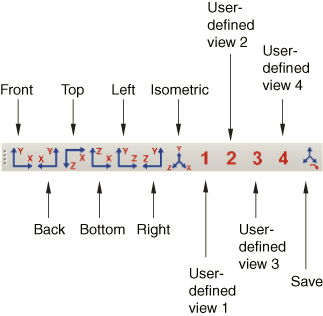Context:
To display the
Views toolbar,
select
from the main menu; the
Views toolbar
is illustrated in the following figure:

The following custom views are available:
-
Front, Back,
Top, Bottom, Left, and
Right: equivalent to observing the model from the six sides
of a cube.
-
Iso: an isometric view. This is the default
orientation for three-dimensional models.
-
User1, User2,
User3, and User4: four user-defined
views. See
Saving a user-defined view,
for a description of how to save a user-defined view.
If the current viewport is linked to other viewports,
Abaqus/CAE
also applies the same custom view to all linked viewports in your session. For
more information, see
Linking viewports for view manipulation.
If it is not visible already, display the
Views toolbar
by selecting
from the main menu.
Abaqus/CAE
displays the
Views toolbar.
From the
Views toolbar,
click the desired tool.
If you have only one viewport,
Abaqus/CAE
immediately applies the selected view and unselects it from the
Views toolbar.
If you have more than one viewport, place the cursor over the viewport whose
view you want to change. The cursor changes to a triad; click, and
Abaqus/CAE
applies the selected view to that viewport.
Note:
When you apply a view that was saved with the
Auto-fit option selected, the view adopts the orientation
of the saved view and immediately rescales it to fill the viewport. When you
apply a view that was saved with the Save current option
selected, the view adopts the orientation, zoom factor, and position of the
saved view.
Repeat Step 2 as many times as necessary to achieve the desired view.
